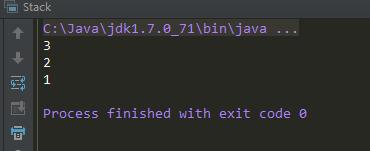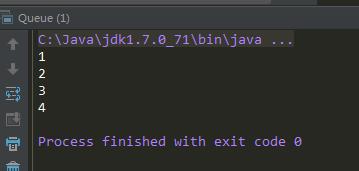面試的時候,棧和隊列經常會成對出現來考察。本文包含棧和隊列的如下考試內容:
(1)棧的創建
(2)隊列的創建
(3)兩個棧實現一個隊列
(4)兩個隊列實現一個棧
(5)設計含最小函數min()的棧,要求min、push、pop、的時間復雜度都是O(1)
(6)判斷棧的push和pop序列是否一致
1、棧的創建:
我們接下來通過鏈表的形式來創建棧,方便擴充。
代碼實現:
|
1
2
3
4
5
6
7
8
9
10
11
12
13
14
15
16
17
18
19
20
21
22
23
24
25
26
27
28
29
30
31
32
33
34
35
36
37
38
39
40
41
42
43
44
45
46
47
48
49
50
|
public class Stack {public Node head; public Node current;//方法:入棧操作 public void push(int data) { if (head == null) { head = new Node(data); current = head; } else { Node node = new Node(data); node.pre = current;//current結點將作為當前結點的前驅結點 current = node; //讓current結點永遠指向新添加的那個結點 } }public Node pop() { if (current == null) { return null; }Node node = current; // current結點是我們要出棧的結點 current = current.pre; //每出棧一個結點后,current后退一位 return node;}class Node { int data; Node pre; //我們需要知道當前結點的前一個結點public Node(int data) { this.data = data; } }public static void main(String[] args) {Stack stack = new Stack(); stack.push(1); stack.push(2); stack.push(3);System.out.println(stack.pop().data); System.out.println(stack.pop().data); System.out.println(stack.pop().data); }} |
入棧操作時,14、15行代碼是關鍵。
運行效果:

2、隊列的創建:
隊列的創建有兩種形式:基于數組結構實現(順序隊列)、基于鏈表結構實現(鏈式隊列)。
我們接下來通過鏈表的形式來創建隊列,這樣的話,隊列在擴充時會比較方便。隊列在出隊時,從頭結點head開始。
代碼實現:
入棧時,和在普通的鏈表中添加結點的操作是一樣的;出隊時,出的永遠都是head結點。
|
1
2
3
4
5
6
7
8
9
10
11
12
13
14
15
16
17
18
19
20
21
22
23
24
25
26
27
28
29
30
31
32
33
34
35
36
37
38
39
40
41
42
43
44
45
46
47
48
49
50
51
|
public class Queue { public Node head; public Node curent;//方法:鏈表中添加結點 public void add(int data) { if (head == null) { head = new Node(data); curent = head; } else { curent.next = new Node(data); curent = curent.next; } }//方法:出隊操作 public int pop() throws Exception { if (head == null) { throw new Exception("隊列為空"); }Node node = head; //node結點就是我們要出隊的結點 head = head.next; //出隊之后,head指針向下移return node.data;}class Node { int data; Node next;public Node(int data) { this.data = data; } }public static void main(String[] args) throws Exception { Queue queue = new Queue(); //入隊操作 for (int i = 0; i < 5; i++) { queue.add(i); }//出隊操作 System.out.println(queue.pop()); System.out.println(queue.pop()); System.out.println(queue.pop());}} |
運行效果:

3、兩個棧實現一個隊列:
思路:
棧1用于存儲元素,棧2用于彈出元素,負負得正。
說的通俗一點,現在把數據1、2、3分別入棧一,然后從棧一中出來(3、2、1),放到棧二中,那么,從棧二中出來的數據(1、2、3)就符合隊列的規律了,即負負得正。
完整版代碼實現:
|
1
2
3
4
5
6
7
8
9
10
11
12
13
14
15
16
17
18
19
20
21
22
23
24
25
26
27
28
29
30
31
32
33
34
35
36
37
38
39
40
41
42
43
44
45
46
47
48
49
50
51
|
import java.util.Stack;/*** Created by smyhvae on 2015/9/9.*/public class Queue {private Stack<Integer> stack1 = new Stack<>();//執行入隊操作的棧 private Stack<Integer> stack2 = new Stack<>();//執行出隊操作的棧//方法:給隊列增加一個入隊的操作 public void push(int data) { stack1.push(data);}//方法:給隊列正價一個出隊的操作 public int pop() throws Exception {if (stack2.empty()) {//stack1中的數據放到stack2之前,先要保證stack2里面是空的(要么一開始就是空的,要么是stack2中的數據出完了),不然出隊的順序會亂的,這一點很容易忘while (!stack1.empty()) { stack2.push(stack1.pop());//把stack1中的數據出棧,放到stack2中【核心代碼】 }}if (stack2.empty()) { //stack2為空時,有兩種可能:1、一開始,兩個棧的數據都是空的;2、stack2中的數據出完了 throw new Exception("隊列為空"); }return stack2.pop(); }public static void main(String[] args) throws Exception { Queue queue = new Queue(); queue.push(1); queue.push(2); queue.push(3);System.out.println(queue.pop());queue.push(4);System.out.println(queue.pop()); System.out.println(queue.pop()); System.out.println(queue.pop());}} |
注意第22行和第30行代碼的順序,以及注釋,需要仔細理解其含義。
運行效果:

4、兩個隊列實現一個棧:
思路:
將1、2、3依次入隊列一, 然后最上面的3留在隊列一,將下面的2、3入隊列二,將3出隊列一,此時隊列一空了,然后把隊列二中的所有數據入隊列一;將最上面的2留在隊列一,將下面的3入隊列二。。。依次循環。
代碼實現:
|
1
2
3
4
5
6
7
8
9
10
11
12
13
14
15
16
17
18
19
20
21
22
23
24
25
26
27
28
29
30
31
32
33
34
35
36
37
38
39
40
41
42
43
44
45
46
47
48
|
import java.util.ArrayDeque;import java.util.Queue;/*** Created by smyhvae on 2015/9/9.*/public class Stack {Queue<Integer> queue1 = new ArrayDeque<Integer>(); Queue<Integer> queue2 = new ArrayDeque<Integer>();//方法:入棧操作 public void push(int data) { queue1.add(data); }//方法:出棧操作 public int pop() throws Exception { int data; if (queue1.size() == 0) { throw new Exception("棧為空"); }while (queue1.size() != 0) { if (queue1.size() == 1) { data = queue1.poll(); while (queue2.size() != 0) { //把queue2中的全部數據放到隊列一中 queue1.add(queue2.poll()); return data; } } queue2.add(queue1.poll()); } throw new Exception("棧為空");//不知道這一行的代碼是什么意思 }public static void main(String[] args) throws Exception { Stack stack = new Stack();stack.push(1); stack.push(2); stack.push(3);System.out.println(stack.pop()); System.out.println(stack.pop()); stack.push(4); }} |
運行效果:

5、設計含最小函數min()的棧,要求min、push、pop、的時間復雜度都是O(1)。min方法的作用是:就能返回是棧中的最小值。【微信面試題】
普通思路:
一般情況下,我們可能會這么想:利用min變量,每次添加元素時,都和min元素作比較,這樣的話,就能保證min存放的是最小值。但是這樣的話,會存在一個問題:如果最小的元素出棧了,那怎么知道剩下的元素中哪個是最小的元素呢?
改進思路:
這里需要加一個輔助棧,用空間換取時間。輔助棧中,棧頂永遠保存著當前棧中最小的數值。具體是這樣的:原棧中,每次添加一個新元素時,就和輔助棧的棧頂元素相比較,如果新元素小,就把新元素的值放到輔助棧中,如果新元素大,就把輔助棧的棧頂元素再copy一遍放到輔助棧的棧頂;原棧中,出棧時,
完整代碼實現:
|
1
2
3
4
5
6
7
8
9
10
11
12
13
14
15
16
17
18
19
20
21
22
23
24
25
26
27
28
29
30
31
32
33
34
35
36
37
38
39
40
41
42
43
44
45
46
47
|
import java.util.Stack;/*** Created by smyhvae on 2015/9/9.*/public class MinStack {private Stack<Integer> stack = new Stack<Integer>(); private Stack<Integer> minStack = new Stack<Integer>(); //輔助棧:棧頂永遠保存stack中當前的最小的元素public void push(int data) { stack.push(data); //直接往棧中添加數據//在輔助棧中需要做判斷 if (minStack.size() == 0 || data < minStack.peek()) { minStack.push(data); } else { minStack.add(minStack.peek()); //【核心代碼】peek方法返回的是棧頂的元素 } }public int pop() throws Exception { if (stack.size() == 0) { throw new Exception("棧中為空"); }int data = stack.pop(); minStack.pop(); //核心代碼 return data; }public int min() throws Exception { if (minStack.size() == 0) { throw new Exception("棧中空了"); } return minStack.peek(); }public static void main(String[] args) throws Exception { MinStack stack = new MinStack(); stack.push(4); stack.push(3); stack.push(5);System.out.println(stack.min()); }} |
運行效果:

6、判斷棧的push和pop序列是否一致:
通俗一點講:已知一組數據1、2、3、4、5依次進棧,那么它的出棧方式有很多種,請判斷一下給出的出棧方式是否是正確的?
例如:
數據:
1、2、3、4、5
出棧1:
5、4、3、2、1(正確)
出棧2:
4、5、3、2、1(正確)
出棧3:
4、3、5、1、2(錯誤)
完整版代碼:
|
1
2
3
|
import java.util.Stack;/*** Created by smyhvae on 2015/9/9.<br>*/<br>public class StackTest {<br><br>//方法:data1數組的順序表示入棧的順序。現在判斷data2的這種出棧順序是否正確<br> public static boolean sequenseIsPop(int[] data1, int[] data2) {<br> Stack<Integer> stack = new Stack<Integer>(); //這里需要用到輔助棧<br><br>for (int i = 0, j = 0; i < data1.length; i++) {<br> stack.push(data1[i]);<br><br>while (stack.size() > 0 && stack.peek() == data2[j]) {<br> stack.pop();<br> j++;<br> }<br> }<br> return stack.size() == 0;<br> }<br><br>public static void main(String[] args) {<br><br>Stack<Integer> stack = new Stack<Integer>();<br><br>int[] data1 = {1, 2, 3, 4, 5};<br> int[] data2 = {4, 5, 3, 2, 1};<br> int[] data3 = {4, 5, 2, 3, 1};<br><br>System.out.println(sequenseIsPop(data1, data2));<br> System.out.println(sequenseIsPop(data1, data3));<br> }<br>}<br><br> |
代碼比較簡潔,但也比較難理解,要仔細體會。
運行效果:

以上就是有關java棧和隊列的經典面試題目,希望可以幫助大家順利通過面試。











